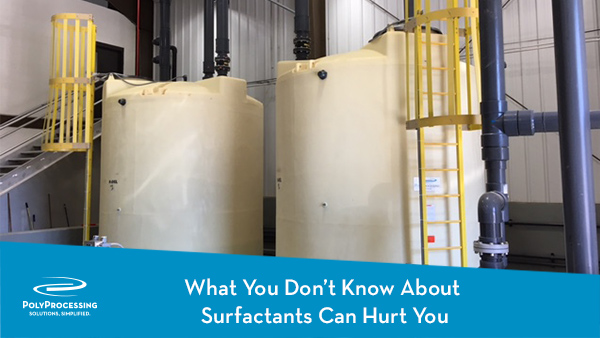What You Don’t Know About Surfactants Can Hurt You
Surfactants are the corn syrup of the chemical world—they’re in all kinds of products you’d never expect. Most people know that surfactants are an active ingredient in detergents, but you can also find them in a wide range of cleaning products, wetting agents, emulsifiers (including motor oil), foaming agents or dispersants.

Be Cautious with Surfactants
That’s important to know, because surfactants are surprisingly destructive to certain types of chemical storage tanks. For example, we use the surfactant Igepal for our gel test. This test is used to determine the percentage of crosslinked polyethylene in our tanks. We place a sample of a tank wall in boiling Igepal, which dissolves any linear polyethylene and leaves only the cross-linked polyethylene (XLPE) behind.
In other words, if you’re using a linear polyethylene tank to store materials that contain surfactants, the surfactants could possibly attack your tank wall over time and destroy the linear polyethylene.
Safely Storing Surfactants
 Cross-linked polyethylene tanks are designed to withstand surfactants and perform for decades. There are other viable systems available, but XLPE tanks match their performance at a third of the price. XLPE is the most cost-effective material for storing surfactants. National companies prefer to use our tanks because of their cost-effectiveness.
Cross-linked polyethylene tanks are designed to withstand surfactants and perform for decades. There are other viable systems available, but XLPE tanks match their performance at a third of the price. XLPE is the most cost-effective material for storing surfactants. National companies prefer to use our tanks because of their cost-effectiveness.
Even tank fittings are vulnerable. We ran into this problem with our tanks that were storing firefighting foam, which is surfactant-based. We used linear chemical bolts for the flanges in our tanks, but the foam cracked the bolt heads and completely destroyed them. We’ve changed our practice for this application, but it illustrates an important point: any linear polymer in your tank is a susceptible to attack.
The Right Storage Solution for Your Needs
Surfactants are in more products than most people realize. It’s important to know if the materials you’re storing contain it, and to switch your tanks to a XLPE system instead of a cheaper grade of polyethylene or even fiberglass. For a robust, cost-effective storage system, cross-linked polyethylene is the material of choice. Talk to a chemical storage tank expert about our customized storage solutions for surfactants.
- February 27, 2019
- Topics: Tank Design and Materials, Chemical Storage
About Poly Processing
Posts By Topic
Tech Talk Podcast Episodes
Subscribe By Email
Recent Posts
- Installation Tips for Chemical Storage Tanks: Site Preparation and Offloading
- Understanding pH and Chemical Concentration When Choosing a Chemical Tank
- Maximizing Fill Efficiency: Selecting the Optimal Fill Line System
- Chemical Storage Tanks: A Quick Guide for End Users
- Popular Customization Options for Chemical Storage Tanks
Tank Configurator

Find the recommended tank and system components for your chemical storage challenge.
Configure a Tank Package


